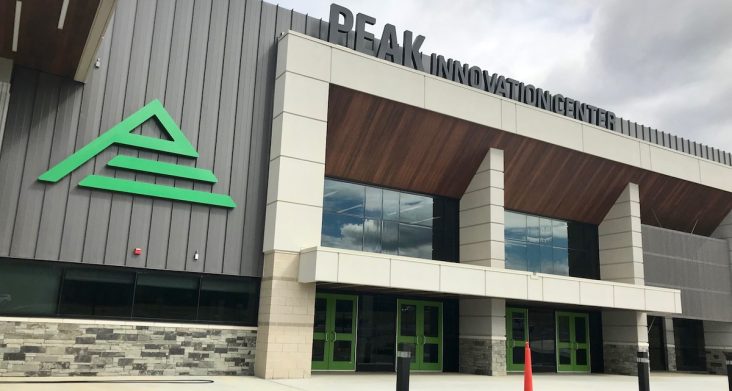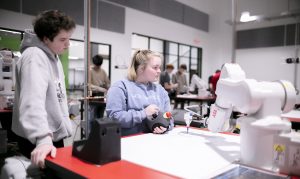Peak Innovation Center in Fort Smith opens to students
by March 28, 2022 6:23 pm 2,733 views

The opening of Fort Smith Public School’s Peak Innovation Center finally opened for students Monday (March 28). Numerous “construction challenges” delayed the opening, which was expected in August, but when students returned from Spring Break on Monday, they did so in the new building.
Students from Northside and Southside high schools joined students from across the area enrolled in the Western Arkansas Technical Center program through the University of Arkansas at Fort Smith.
“At the Peak Innovation Center, students complete college courses and earn credentials while still attending high school,” said Dr. Latisha Settlage, dean of the College of Business and Industry at UAFS. “Through WATC, we can offer concurrent credits that not only bolster college portfolios and shorten the timeline to earning bachelor’s degrees, but which also lead to completion of technical certificates, certificates of proficiency, and even associate degrees in high-demand fields while students are still in high school.”
Classes that were being conducted on Monday at the new building were those in Phase One at Peak, FSPS officials said. Those included: Automation and robotics; computer integrated machining; electronics technology/industrial maintenance; emergency medical responder; medical office assistant; network engineering; and unmanned aerial systems. All Phase One programs are taught by UAFS/WATC faculty.
“We are thrilled students from around the region will have the opportunity to experience hands-on training in labs that feature state-of-the-art equipment unmatched in our state, ensuring that we can continue to raise the trajectory of students’ success,” said Dr. Gary Udouj, director of career education and district innovation for Fort Smith Public Schools.
Students enrolled in automotive technology, computer-aided drafting, and welding will remain at the UAFS campus, UAFS officials said. The certified nursing assistant and licensed practical nursing programs will finish the spring semester at the UAFS campus, but will be offered at Peak this fall.
The UAFS WATC program works with 22 school districts from Crawford, Franklin, Johnson, Logan, Scott, and Sebastian Counties, providing concurrent credit classes at no charge to participating high-school juniors and seniors. About 150 of the WATC students will be finishishing the semester at the Peak Innovation Center, said Amanda Seidenzahl, WATC director. There are 335 students enrolled in WATC this semester.

“The classes the students are taking here align with many of our university degree programs, so they are earning certificates of proficiency, technical certifications, and we even have a student graduating this semester with an associate degree,” Seidenzahl said.
The students can then roll straight into a bachelor’s degree program at UAFS, she added. She cited the example of students in the robotics and automation program who can convene an associate degree then complete a bachelor’s degree in electrical engineering technology.
“All of our programs are very hands- on with knowledge-based and skills-based learning. (Students also) have the opportunity to apply for a youth apprenticeship,” she said. “It is a work and learning opportunity. They can continue and finish up their degree plan or go to work or they can do both.”
Seidenzahl said seeing the collaboration between FSPS, UAFS, local industry and the Fort Smith Regional Chamber of Commerce come to fruition with the opening of the Peak Innovation Center Monday was rewarding for students, faculty and staff.
“It’s exciting to see the students here. We’ve been talking about it for a very long time,” she said. “The building and facility is owned by FSPS, so it’s definitely a collaborative partnership with them. They have taken the lead on getting the funding and most of the equipment that is here.”
FSPS provided the equipment for the computer integrated machining, automation robotics, electronics technology, emergency medical responder and CNA programs with grants and donations, said Christina Williams, coordinator of public information for FSPS. UAFS is providing equipment for the LPN and network engineering technology programs with Regional Workforce Grants, she added.
The Peak Innovation Center was originally expected to be open to students for the start of the school 2021-22 school year. In June Shawn Shaffer, FSPS facilities supervisor, informed the school board that date would be pushed to the start of the second semester. The FSPS school board was told in November the facility would be finished Dec. 23, allowing students to attend the center Jan. 4 when school resumed. In January, the district said construction issues, including supply chain problems and labor shortages, delayed the opening of the center.
In July, Shaffer also told the school board the center was coming in $6.6 million over budget. The anticipated final cost of the project, including phase two work with an elevator and roof replacement but not including art, is $19.076 million, about $6.6 million more than originally planned. That cost includes $18.627 million committed or budgeted funds and $450,000 in non-committed contingency funds, Shaffer said.
The second phase of construction at Peak is still to come. That phase will include the visual arts programing, the ArcBest Community Room and the Fort Smith Virtual Academy. The ArcBest Community Room is expected to cost about $1 million, Shaffer said. The 13,000-square-foot room is estimated to be completed in October. It will be used for community events, school competitions, professional training, banquets and more. The cost of the room will be covered by the $1 million donation from ArcBest.
The expected cost of the virtual academy is expected to be $1.2 million, which will be covered by American Rescue Plan Elementary and Secondary School Emergency Relief (ARP ESSER) funds. ESSER funds have a timetable of three years to be used, meaning districts that receive funds have a three-year window to complete projects using the funds. That three-year window started in July 2021. The art classroom is estimated to cost $500,000, Shaffer told the FSPS school board in February.
